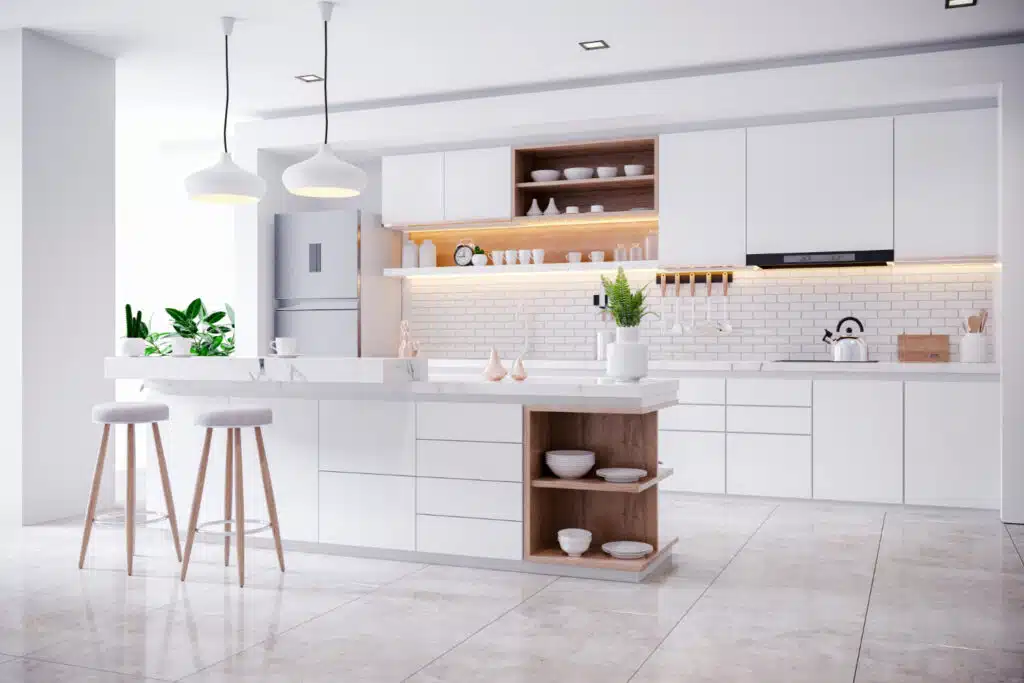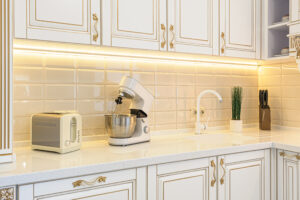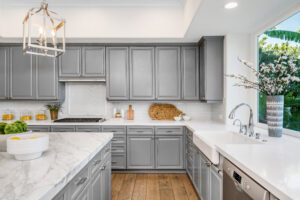The kitchen, known as the heart of the home, is where culinary creations come to life, and cherished memories are made. Selecting the right kitchen design is crucial, as it sets the tone for the entire space, harmonizing functionality with aesthetics. Whether you’re building a new home or renovating your current kitchen, this comprehensive guide will provide you with essential tips and considerations to make an informed decision that aligns with your style, needs, and budget. Let us help you create a space where culinary creations thrive and cherished memories are made.
Tips for Creating an Admirable Kitchen
Planning the Layout of Your Dream Kitchen
Designing a kitchen layout requires careful consideration of the available space and the functional requirements of the kitchen. Take note of any structural elements like pillars or beams that might affect the layout, and measure the dimensions of your kitchen, including the walls, windows, and doors. Before starting the design process, it’s important to understand the concept of the work triangle.
The work triangle is a design principle that suggests placing the three most frequently used elements in the kitchen—the sink, stove, and refrigerator—in a triangular formation. Ideally, the total sum of the triangle’s sides should range between 12 and 26 feet for optimal efficiency. Evaluate your kitchen’s existing infrastructure and determine the most practical placement for the sink, stove, and refrigerator. They should form a triangle, with each side measuring between 4 and 9 feet.
This arrangement minimizes unnecessary movement and maximizes efficiency. Ensure you have ample countertop space near the primary work area and cooking area. Consider including an island or peninsula if space allows, as it can provide additional workspace and seating.
Prioritize Storage for Better Organization
When it comes to prioritizing storage in the kitchen, consider both functionality and organization. Start by evaluating your kitchen tools, appliances, and utensils to determine what needs to be stored. Make efficient use of cabinet space by installing adjustable shelving, pull-out drawers, and organizers. Utilize stackable containers or bins to maximize vertical space.
Install open shelves or wall-mounted racks to keep frequently used items within reach, such as spice racks, pot racks, or utensil holders. If you have high ceilings or space above your cabinets, consider adding overhead storage for infrequently used items or seasonal kitchenware. Hooks or a pegboard system on the walls or inside cabinet doors can be used to hang pots, pans, and frequently used tools, saving space and providing easy access.
Maximize the space under the sink by using stackable bins, sliding drawers, or expandable shelves. This will help keep cleaning supplies, dishwashing products, and other items organized and easily accessible. Install corner cabinets with rotating shelves (lazy Susan) or pull-out organizers to make the most of the often-wasted space in kitchen cabinets.
Choose Quality Materials
Selecting high-quality materials is essential when designing a new kitchen to ensure a beautiful and long-lasting space. Flooring in the kitchen is subjected to heavy use and moisture, so it’s important to choose a material that can withstand these conditions. Hardwood or tile flooring is a classic choice known for its durability and timeless appeal.
Countertops play a central role in both functionality and visual appeal. Granite is a popular choice due to its natural beauty, durability, and heat resistance. For a wider range of colors and patterns, quartz countertops offer excellent durability as an engineered stone option. When it comes to cabinets, solid wood is a timeless choice that adds warmth and character to any kitchen. Plywood cabinets provide strength and durability while being budget-friendly. Medium-density fiberboard (MDF) is another cost-effective option, ideal for painted finishes.
Lighting Matters
Lighting is a crucial consideration when designing a new kitchen, as it affects both functionality and aesthetics. To create a well-lit and welcoming space, incorporate a mix of ambient, task, and accent lighting.
Task lighting is essential for specific work areas such as countertops, stoves, sinks, and food preparation areas. Under-cabinet lighting is an excellent option for illuminating the countertop, eliminating shadows, and enhancing visibility. Pendant lights or adjustable recessed lights can be installed over the kitchen island or breakfast bar to provide focused lighting.
Natural lighting is highly desirable in a kitchen, as it creates a bright and inviting atmosphere. Incorporate large windows, skylights, or glass doors to maximize the amount of natural light. This not only enhances the overall aesthetics but also reduces the need for artificial lighting during the day.
Add Your Personal Touch
Infuse your kitchen with your unique style and personality to create a space that truly feels like your own. Consider incorporating custom details into your kitchen cabinetry, such as unique hardware, personalized engravings, or a custom paint or stain color that resonates with your taste and complements the overall design. Showcase your collections or treasured items on open shelves or glass-front cabinets, whether it’s a collection of vintage dishes, cookbooks, or decorative pieces.
Bringing the outdoors in by adding plants and fresh herbs to your kitchen not only adds a vibrant touch of nature but also contributes to a healthier environment. These plants can be used for cooking or garnishing dishes. You can also infuse your kitchen with a signature scent that reflects your favorite aromas, whether it’s a scented candle, essential oils, or fresh herbs, creating an inviting and personalized atmosphere.
Don’t Forget About Ventilation
Proper ventilation is a critical aspect of kitchen design that should not be overlooked. Install a high-quality range hood above your cooking area, appropriately sized to effectively capture and exhaust smoke, grease, and odors. Choose a hood with sufficient airflow capacity for your stove’s output and consider features like multiple fan speeds and built-in lighting.
Consider the noise level of your chosen ventilation system. Look for models that provide a balance between efficient performance and low-noise operation. Some hoods offer quiet or silent modes when minimal ventilation is required. By considering proper quality ventilation solutions, you can effectively remove cooking odors, smoke, and excess moisture, ensuring a fresh and enjoyable cooking experience.
Consider Electrical Outlets
When designing your dream kitchen, don’t overlook the importance of electrical outlets. Adequate placement of outlets is essential to ensure convenience and accessibility for your kitchen appliances and gadgets. Plan the location of outlets strategically, ensuring they are easily accessible from countertops and cooking areas. Consider adding extra outlets in areas where you anticipate needing more power, such as near the coffee maker or blender. Furthermore, consider installing USB outlets or charging stations for convenient charging of your electronic devices. By carefully considering electrical outlets, you can create a functional and efficient kitchen that meets all your power needs.
Wrapping Up
Choosing the right kitchen design requires careful planning and consideration of your needs. When planning a kitchen remodel, it’s crucial to collaborate with a capable team that can bring your vision to life. At Impressions Kitchen, we take pride in making your dream kitchen a reality by providing exceptional design services, customer support, and superior craftsmanship. Impressions Kitchen’s design staff is eager to discuss your ideas and turn them into a remarkable kitchen that exceeds your expectations.
Contact us today to take one more step toward your dream kitchen.






